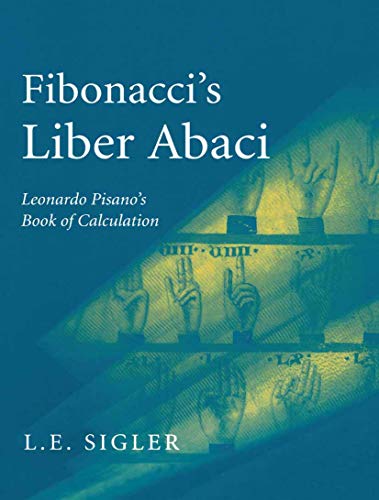Fibonacci?s Liber Abaci: A Translation into Modern English of Leonardo Pisano?s Book of Calculation (Sources and Studies in the History of Mathematics and Physical Sciences)
Laurence Sigler
Verkäufer
Kennys Bookstore, Olney, MD, USA
Verkäuferbewertung 5 von 5 Sternen
![]()
AbeBooks-Verkäufer seit 9. Oktober 2009
Beschreibung
Beschreibung:
Introduces Arabic numerals and methods in Europe. This title is of interest to historians of science, mathematicians and mathematics teachers interested in the origins of their methods. Series: Sources and Studies in the History of Mathematics and Physical Sciences. Num Pages: 638 pages, biography. BIC Classification: PBX. Category: (G) General (US: Trade); (P) Professional & Vocational; (U) Tertiary Education (US: College). Dimension: 255 x 178 x 34. Weight in Grams: 1134. . 2003. Softcover reprint of. Paperback. . . . . Books ship from the US and Ireland. Bestandsnummer des Verkäufers V9780387407371
Inhaltsangabe:
First published in 1202, Fibonacci’s Liber Abaci was one of the most important books on mathematics in the Middle Ages, introducing Arabic numerals and methods throughout Europe. This is the first translation into a modern European language, of interest not only to historians of science but also to all mathematicians and mathematics teachers interested in the origins of their methods.
Über die Autorin bzw. den Autor: Charlotte y Peter Fiell son dos autoridades en historia, teoría y crítica del diseño y han escrito más de sesenta libros sobre la materia, muchos de los cuales se han convertido en éxitos de ventas. También han impartido conferencias y cursos como profesores invitados, han comisariado exposiciones y asesorado a fabricantes, museos, salas de subastas y grandes coleccionistas privados de todo el mundo. Los Fiell han escrito numerosos libros para TASCHEN, entre los que se incluyen 1000 Chairs, Diseño del siglo XX, El diseño industrial de la A a la Z, Scandinavian Design y Diseño del siglo XXI.
Bibliografische Details
Titel: Fibonacci?s Liber Abaci: A Translation into ...
Verlag: Springer
Erscheinungsdatum: 2003
Einband: Softcover
Zustand: New
Beste Suchergebnisse beim ZVAB
Fibonacci's Liber Abaci: A Translation into Modern English of Leonardo Pisano's Book of Calculation (Sources and Studies in the History of Mathematics and Physical Sciences)
Anbieter: Ria Christie Collections, Uxbridge, Vereinigtes Königreich
Zustand: New. In. Artikel-Nr. ria9780387407371_new
Anzahl: Mehr als 20 verfügbar
Anzahl: Mehr als 20 verfügbar
Fibonacci's Liber Abaci
Anbieter: buchversandmimpf2000, Emtmannsberg, BAYE, Deutschland
Taschenbuch. Zustand: Neu. Neuware -First published in 1202, Fibonacci's 'Liber abaci' was one of the most important books on mathematics in the Middle Ages, introducing Arabic numerals and methods throughout Europe.Its author, Leonardo Pisano, known today as Fibonacci, was a citizen of Pisa, an active maritime power, with trading outposts on the Barbary Coast and other points in the Muslim Empire. As a youth Fibonacci was instructed in mathematics in one of these outposts; he continued his study of mathematics while traveling extensively on business and developed contacts with scientists throughout the Mediterranean world. A member of the academic court around the Emperor Frederick II, Leonardo saw clearly the advantages for both commerce and scholarship of the Hindu positional number system and the algebraic methods developed by al-Khwarizmi and other Muslim scientists.Though it is known as an introduction to the Hindu number system and the algorithms of arithmetic that children now learn in grade school, 'Liber abaci' is much more: an encyclopaedia of thirteenth-century mathematics, both theoretical and practical. It develops the tools rigorously, establishing them with Euclidean geometric proofs, and then shows how to apply them to all kinds of situations in business and trade - conversion of measures and currency, allocations of profit, computation of interest, alloying of currencies, and so forth. It is rigorous mathematics, well applied, and vividly described.As the first translation into a modern language of the 'Liber abaci', this book will be of interest not only to historians of science, but to all mathematicians and mathematics teachers interested in the origins of their methods.Springer Verlag GmbH, Tiergartenstr. 17, 69121 Heidelberg 648 pp. Englisch. Artikel-Nr. 9780387407371
Anzahl: 2 verfügbar
Fibonacci's Liber Abaci : A Translation into Modern English of Leonardo Pisano's Book of Calculation
Anbieter: AHA-BUCH GmbH, Einbeck, Deutschland
Taschenbuch. Zustand: Neu. Druck auf Anfrage Neuware - Printed after ordering - First published in 1202, Fibonacci's 'Liber abaci' was one of the most important books on mathematics in the Middle Ages, introducing Arabic numerals and methods throughout Europe.Its author, Leonardo Pisano, known today as Fibonacci, was a citizen of Pisa, an active maritime power, with trading outposts on the Barbary Coast and other points in the Muslim Empire. As a youth Fibonacci was instructed in mathematics in one of these outposts; he continued his study of mathematics while traveling extensively on business and developed contacts with scientists throughout the Mediterranean world. A member of the academic court around the Emperor Frederick II, Leonardo saw clearly the advantages for both commerce and scholarship of the Hindu positional number system and the algebraic methods developed by al-Khwarizmi and other Muslim scientists.Though it is known as an introduction to the Hindu number system and the algorithms of arithmetic that children now learn in grade school, 'Liber abaci' is much more: an encyclopaedia of thirteenth-century mathematics, both theoretical and practical. It develops the tools rigorously, establishing them with Euclidean geometric proofs, and then shows how to apply them to all kinds of situations in business and trade - conversion of measures and currency, allocations of profit, computation of interest, alloying of currencies, and so forth. It is rigorous mathematics, well applied, and vividly described. As the first translation into a modern language of the 'Liber abaci', this book will be of interest not only to historians of science, but to all mathematicians and mathematics teachers interested in the origins of their methods. Artikel-Nr. 9780387407371
Anzahl: 1 verfügbar
Fibonacci's Liber Abaci: A Translation into Modern English of Leonardo Pisano's Book of Calculation
Anbieter: Revaluation Books, Exeter, Vereinigtes Königreich
Paperback. Zustand: Brand New. 636 pages. 9.50x7.25x1.25 inches. In Stock. Artikel-Nr. x-0387407375
Anzahl: 2 verfügbar

